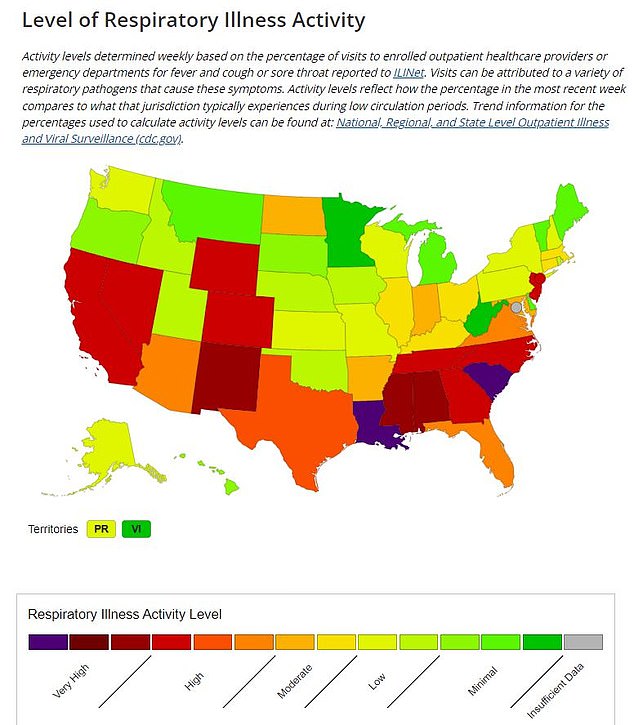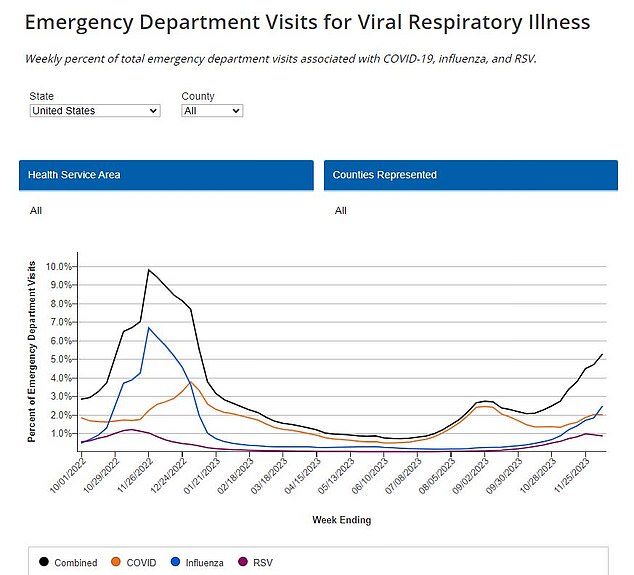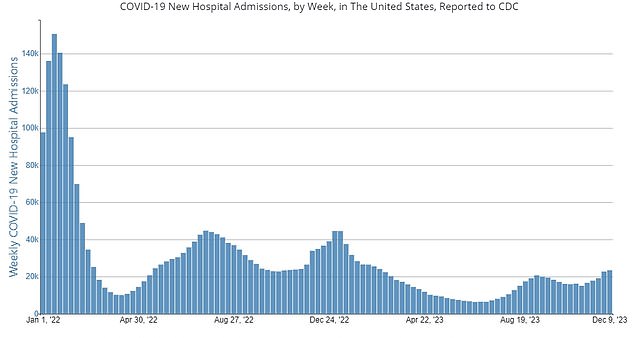CDC sounds alarm over new Covid variant JN.1 it says could leave hospitals and emergency rooms forced to ration care
Hospitals and emergency rooms could be forced to ration care by the end of this month due to the spread of a new, highly contagious Covid variant.
The JN.1 variant is responsible for an increasing number of cases, the CDC said. It now accounts for up to 29 percent of Covid cases, a sharp increase from less than one percent in early November.
Covid is the biggest driver of hospital admissions, with more than 23,000 new hospital admissions in the week ending December 9 – the fifth week in a row that numbers have risen and the highest level since February.
The CDC warned that the strain on the health care system could mean that “patients with other serious health conditions may face delays in receiving care.”
The number of hospital admissions due to Covid per province in the past three months. In most of the country there were fewer than ten hospital admissions per 100,000 inhabitants

Louisiana, South Carolina and New Mexico have very high levels of respiratory illness, according to the CDC, as do Mississippi and Alabama
What makes the situation even more precarious is that the number of flu hospital admissions is also increasing. new admissions reached 7,090 for the week ending December 9, compared to 5,816 for the week ending December 2.
The CDC predicts that up to 18,000 hospitalizations due to flu are likely to be reported in the last week of December.
For the week ending December 9 flu rates were eight per 100,000 people in the US, compared to 36 per 100,000 this time last year.
The number of cases of respiratory syncytial virus (RSV) is also increasing. Louisiana, South Carolina and New Mexico have very high levels of respiratory illness, according to the CDC, as do Mississippi and Alabama.
In the week ending December 9, the rate of RSV hospitalizations was 2.3 per 100,000 people, compared to 3.3 at this time last year.
Whitney Marvin, a pediatric intensive care specialist at the Medical University of South Carolina Shawn Jenkins Children's Hospital, told the Washington Post that this year is the worst RSV season she can remember.
Children are staying in the hospital longer because they are sicker, and the RSV season started later than last year, meaning RSV overlaps with the peak of other winter respiratory viruses, including influenza.
Dr. Marvin's hospital has been forced to work with other hospitals in the state and in nearby North Carolina to divert patients.
The CDC said, “In some parts of the country, hospital beds for children are already nearly as full as they were this time last year.
“If these trends continue, the situation could put renewed pressure on emergency departments and hospitals by the end of this month.”
Emergency room data released Wednesday shows the number of emergency department visits by school-age children nearly doubled last week.
The spike is mainly due to increased flu cases after numbers held steady leading up to Thanksgiving.
But an increase in travel and family gatherings, as well as cold weather forcing people to spend more time indoors, is likely to further increase respiratory disease rates.

Hospitalizations for Covid, RSV and flu are rising across the country, coupled with low vaccination rates for all three, the CDC warned

CDC data shows that daily hospitalizations due to Covid increased three percent in the first week of December. There were 23,432 hospitalizations in the week ending December 9, according to the latest available data. This is lower than the 34,932 hospital admissions at this time last year

Covid-19 deaths remain low – at 723 in the week ending December 9, compared to 3,035 this time last year
In a similar situation to last year, the number of emergency room visits for flu in most age groups is surpassing Covid for the first time in months.
Only among people over 65 are Covid rates still higher than flu.
And nursing homes have recently suffered a sharp increase in the number of Covid-19 infections.
The rise in cases is likely due to the JN.1 variant which experts believe could be more contagious and which the CDC says recently announced that it is being tracked.
The agency estimates that the variant accounted for almost 30 percent of Covid cases in the US in the first week of December, up from nine percent at the end of November.
The CDC said it is currently the fastest-growing variant in the country, and its presence will continue to increase.
The new variant was first discovered in the US in September and made up just 0.1 percent of Covid cases in October.
Due to its rapid spread, the CDC believes it is either more transmissible or better at evading the human immune system.
Still, there is no evidence that the variant poses an increased risk to people, and there is no evidence that it is more serious than previous variants.
JN.1 is very similar to the previous BA.2.86 variant, with only a single change that mutates in the virus's spike protein.
A group of experts organized by the World Health Organization concluded this month that the changes in JN.1 are not drastic enough to require a review of this season's vaccines, but emphasized that the sots were less effective at combating the strain.
The CDC has also warned about low vaccination rates for Covid, flu and RSV.
Insurance claims data shows flu shots are roughly eight million doses lower than last year's vaccination levels.
Flu shots for children are also down about five percentage points compared to last year, according to CDC survey data.
In nursing homes, only a third of residents and fewer than one in ten staff members have been vaccinated with the latest Covid injection.
“It will be very difficult, if not possible, to cover the lost volume,” vaccine manufacturers said at a recent stakeholder meeting with the CDC.
CDC data shows that daily hospitalizations due to Covid increased three percent in the first week of December.
There were 23,432 hospitalizations in the week ending December 9, according to the latest available data.
This is lower than the 34,932 hospital admissions at this time last year.
Covid deaths remain low: 723 in the week ending December 9, compared to 3,035 this time last year.
